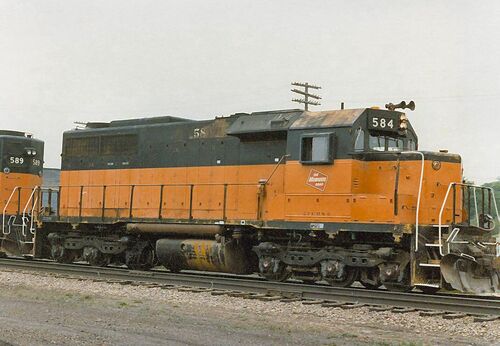by JonCavender
I tend to find most standard-gauge articulated steam locomotives unattractive to the eye. Narrow-gauge steam locomotives, including articulated ones, do tend to be prettier to the eye. The notable exception would have to be this one-off 1910 2-6-6-2 standard-gauge mallet that was built by Baldwin for the Portland & Southwestern Railroad. This engine was shamefully scrapped many decades ago and no engine like this seems to be in existence anymore. What I like about the visual style is the chromed/whitewall wheels, the prominent cylindrical smokestack and tall domes and the roof line of the cab which extends above the top of the boiler. This engine's exterior is relatively clean and uncluttered. Many later standard-gauge American locomotives were ungainly. They had a high boiler line. Cab roofs about the height of the boiler, stubby domes and stacks and often a lot of exterior clutter. The streamlined steamers looked weird too. For a non-articulated steam loco, I prefer the looks of the pre-1930 UP/SP Baldwin consolidations in standard-gauge. They tended to have typical narrow-gauge cuteness with a lower boiler top line, taller cab and higher domes and stacks. The 1924 Baldwin 2-8-2 mikado Old 45 of the Skunk Train in northern California is a cute model engine too but I find the driving wheels rather dinky in diameter.
This is the cutest style for an articulated standard gauge engine I have ever seen to date. If were to have a scale-model engine, this is definitely the style I would want. If I were a multi-billionaire with a private RR offering excursion train service, that one-of-a-kind 1910 Baldwin mallet style is what I would want in a custom-built replica steam engine for my line fueled by LP or NG. I am not a fan of tank engines but prefer the looks of steam locos with separate tenders. There is a special mystique for articulated steam locomotives and they can handle the sharper turns in wooded mountain railroading. Basically, I find American locomotives and rolling stock, historic and current, much more visually attractive than that of other parts of the world.
There are three different articulated engine styles at this following link pictured, you decide which looks the cutest:
http://i1252.photobucket.com/albums/hh5 ... nribg5.png" onclick="window.open(this.href);return false;
This is the cutest style for an articulated standard gauge engine I have ever seen to date. If were to have a scale-model engine, this is definitely the style I would want. If I were a multi-billionaire with a private RR offering excursion train service, that one-of-a-kind 1910 Baldwin mallet style is what I would want in a custom-built replica steam engine for my line fueled by LP or NG. I am not a fan of tank engines but prefer the looks of steam locos with separate tenders. There is a special mystique for articulated steam locomotives and they can handle the sharper turns in wooded mountain railroading. Basically, I find American locomotives and rolling stock, historic and current, much more visually attractive than that of other parts of the world.
There are three different articulated engine styles at this following link pictured, you decide which looks the cutest:
http://i1252.photobucket.com/albums/hh5 ... nribg5.png" onclick="window.open(this.href);return false;
